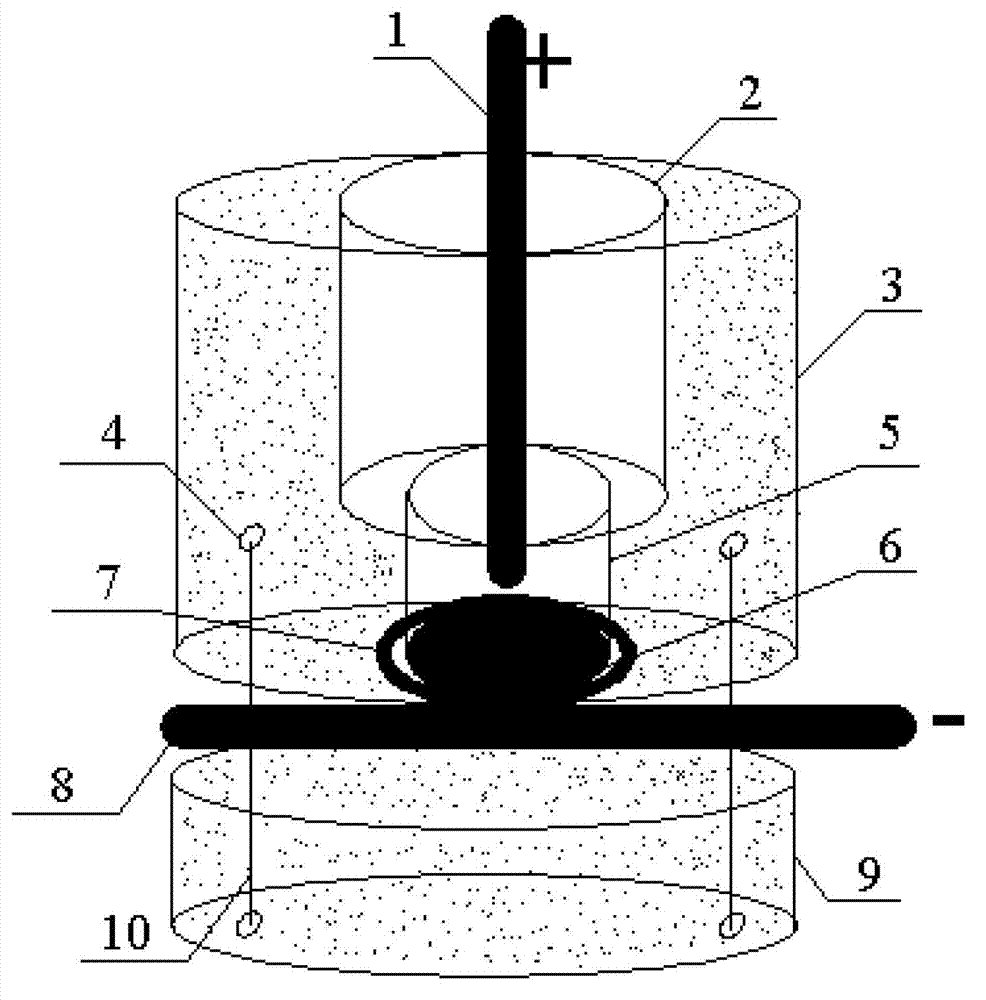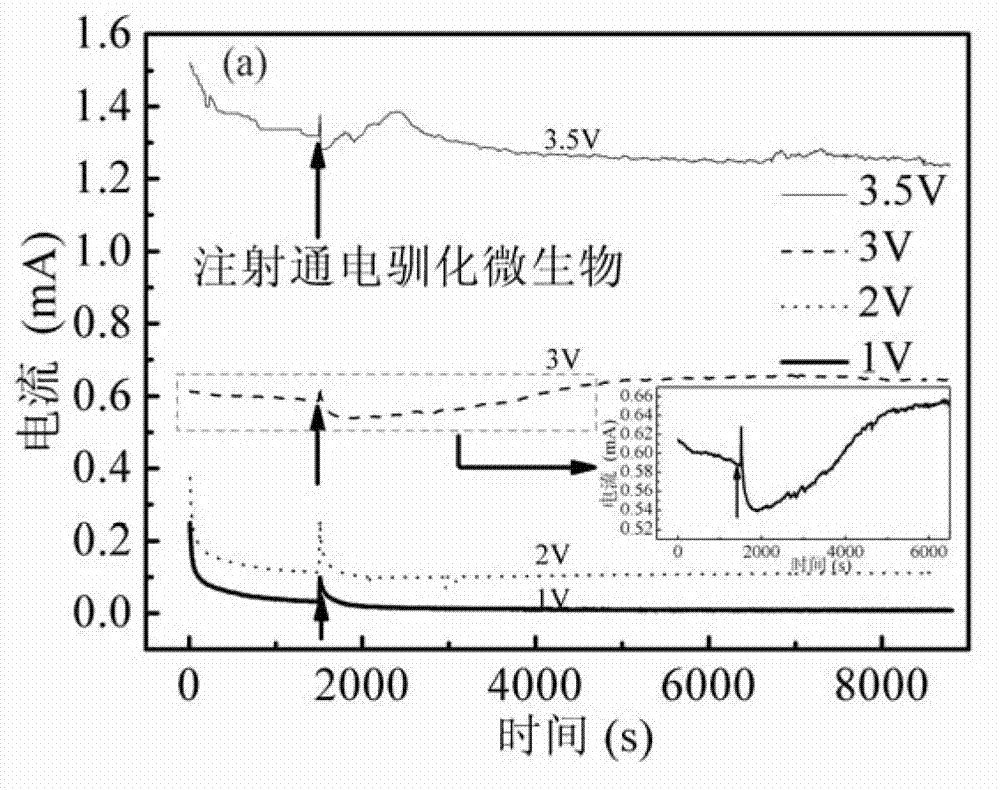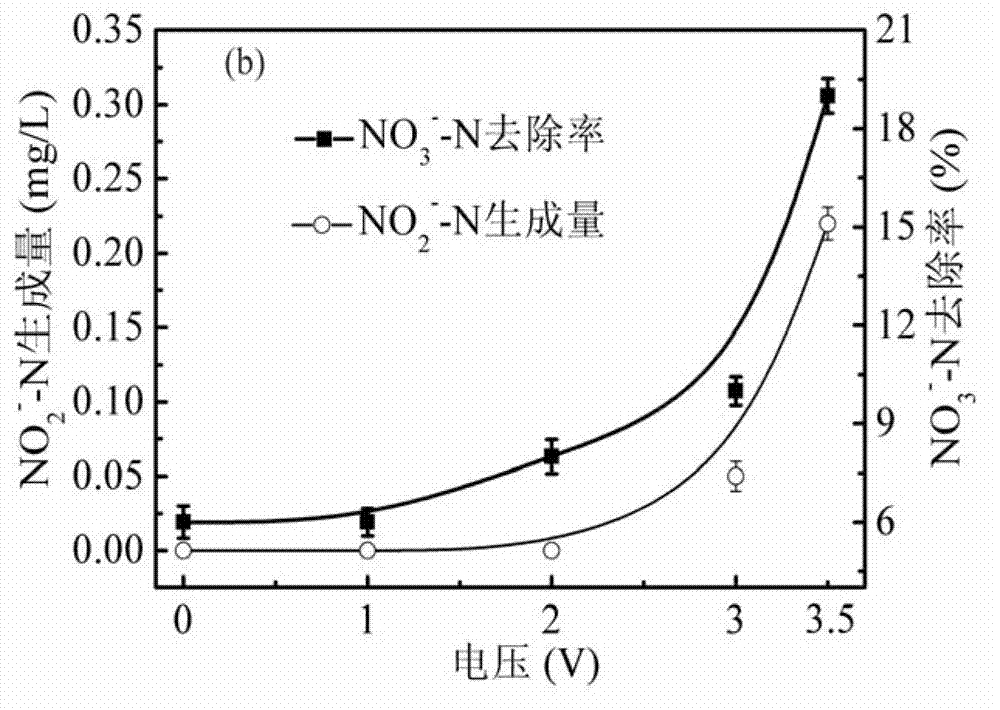Device and method for detecting electron transfer in process of electrically promoted microorganism denitrification
An electron transfer and denitrification technology, applied in chemical instruments and methods, biological water/sewage treatment, water/sludge/sewage treatment, etc., can solve the problems of biofilm dispersion and ineffective detection of electron transfer, and achieve the goal of making Fine, ingenious design of the device, to solve the effect of shedding
- Summary
- Abstract
- Description
- Claims
- Application Information
AI Technical Summary
Problems solved by technology
Method used
Image
Examples
Embodiment 1
[0042] The electron transfer process or rate and the denitrification and denitrification effect of electricity in the device under different voltages.
[0043] Set different voltage values to 1V, 2V, 3V and 3.5V respectively, and inject 6mL of nutrient solution into the reaction device (the composition of the nutrient solution: 30mg / L NO 3 - -N, 80mg / L NaHCO 3 , 5g / LK 2 HPO 4 , 1.5g / L KH 2 PO 4 ), after the current stabilizes, inject 4ml of energized and domesticated microorganisms with a concentration of 10mg / ml into the device. The final concentration of microorganisms in the reaction system is 4mg / ml. The microorganisms are taken from a stable operating electrode biofilm reactor. Observe And the current change value of the recording device, the reaction is ended after the current basically stabilizes, and the total reaction time is about 2.5 hours. Finally, the nutrient solution in the device is poured out, and the water quality index in the nutrient solution is measured usin...
Embodiment 2
[0046] The process and rate of electron transfer and denitrification and denitrification of the electro-promoted organisms in the device under different final concentrations of microorganisms. Set the voltage value to be constant at 3V, and inject 6 mL of nutrient solution into the reaction device (the composition of the nutrient solution: 30mg / L NO 3 - -N, 80mg / L NaHCO 3 , 5g / L K 2 HPO 4 , 1.5g / LKH 2 PO 4 ), after the current stabilizes, inject 1mL, 2mL, 3mL, 4mL and 5mL of the energized and domesticated microorganisms with a concentration of 10mg / ml respectively into the device. The final concentration of the microorganisms after injection is 1.4mg / ml and 2.5mg / ml respectively , 3.3mg / ml, 4mg / ml and 4.5mg / ml. The microorganisms are taken from a stable electrode biofilm reactor, and the current change value of the device is observed and recorded. The reaction is completed after the current basically stabilizes. The total reaction time is about 2.5 hours, of which the nutrient s...
Embodiment 3
[0050] The electron transfer process and rate of the electro-promoted organisms and the denitrification and denitrification situation in the device under different types of microorganisms. Set the voltage value to be constant at 3V, and inject 6 mL of nutrient solution into the reaction device (the composition of the nutrient solution: 30mg / L NO 3 - -N, 80mg / L NaHCO 3 , 5g / L K 2 HPO 4 , 1.5g / LKH 2 PO 4 ), after the current stabilizes, inject 5 mL of energized domesticated microorganisms and non-energized domesticated microorganisms with a concentration of 10 mg / ml into the device. After injection, the final concentration of the microorganisms in the reaction system is 4.5 mg / ml, and the microorganisms are respectively Taken from a stable operating electrode biofilm reactor (electrical acclimation) and a control reactor with only microorganisms (non-electric acclimation). Observe and record the current change value in the device. After the current basically stabilizes, the reactio...
PUM
 Login to View More
Login to View More Abstract
Description
Claims
Application Information
 Login to View More
Login to View More - R&D
- Intellectual Property
- Life Sciences
- Materials
- Tech Scout
- Unparalleled Data Quality
- Higher Quality Content
- 60% Fewer Hallucinations
Browse by: Latest US Patents, China's latest patents, Technical Efficacy Thesaurus, Application Domain, Technology Topic, Popular Technical Reports.
© 2025 PatSnap. All rights reserved.Legal|Privacy policy|Modern Slavery Act Transparency Statement|Sitemap|About US| Contact US: help@patsnap.com



